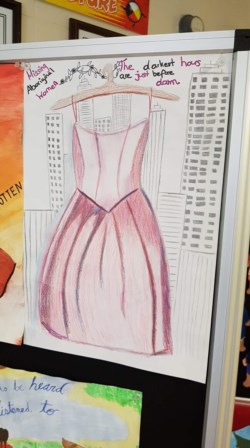Aboriginal Culture Day
Aboriginal Culture Day at HSB
- During this day, teachers sign up their classes to explore 6 stations of Aboriginal culture: cultural items/artifacts, traditional music and dance, traditional food, lacrosse, social justice, and beading & embroidery. Guides move class groups through stations, explaining their Native names to each group and introducing each station. Stations are maintained by other "expert" students who proceed to teach the groups about their station topic. Stations are maintained during lunch as well, so all staff and students have the chance to experience the presentations and culture.
- Last year, 32 students extended Aboriginal Culture Day to our sister high school (CVR), where Aboriginal culture is much less familiar.
Students were impressed with the interest shown in their culture by CVR students and staff. They hope to continue to bring Culture Day to Ormstown in future years.
Mise à jour
(29 avril 2019)
Our annual HSB Aboriginal Culture Day prep is under way. The students are working extremely hard at preparing their kiosks and displays. This year's Culture day includes 5 stations for teachers to sign their classes up to come and see. A total of ten classes will be able to attend. The displays and students will remain at lunch for the rest of the school to see. There will also be a visit from a professional indigenous dancer, Barbara Diabo. She puts together a presentation about her personal journey through hoop dancing and others she performs at Pow wow.
The stations include presentations on
1. Social justice issues including Indigenous profiling and incarceration
2. Art and Culture. This includes art produced by the grade 11 students that was inspired by Jaime Black a Métis artist from Winnipeg http://www.theredressproject.org/ Students also will be presenting information on the Seven Sacred Teachings, variations of the Medicine Wheel, the 4 Sacred Medicines and The numbered treaties between Aboriginal people and Canada
3. Traditional items, beading and clothing which include many students wearing their regalia or ribbon shirts and dresses
4.Traditional and contemporary Indigenous Food. The students made Strawberry Juice, Indian Tacos and Cooked Goose for the attendants to sample.
5. Traditional and Contemporary Indigenous dance.
Mise à jour
(22 mai 2019)
The project was an extreme success!
The students were able to extend the culture day to two more schools (CVR and St. Willibrord Elementary)
The students did a wonderful job describing many aspects of indigenous culture. They shared food, dance, music and social justice issues with staff and students.
Station 1- Social justice
Disproportionate incarceration rates of Indigenous people. Disproportionate number of missing and murdered Indigenous women and girls.
Students prepared information about this unfortunate topic and shared facts in at tasteful and passionate way
They created awareness two separate displays:
The REDress Project
The REDress Project was created by Jaime Black, an emerging Métis artist in Winnipeg. It is an installation art project that focuses on missing and murdered indigenous women in Canada. The artist’s goal was to collect 600 red dresses from community donations and install them in public spaces in Winnipeg and throughout Canada as a tangible reminder of the overwhelming number of women who are no longer with us.
“The empty red dress … marks the absence of these women so we can’t forget that they’re gone,” said Black. “I have a responsibility, just as a human, to make the world a safer place for Indigenous women.”
In an effort to raise awareness and inspire hope here at HSB, Ms. Quagliotto’s grade 11 art class painted their personal interpretations of the Red Dress Project this spring and included messages of acknowledgement and compassion.
Faceless Doll Project
The Native Women’s Association of Canada Faceless Doll Project was launched in 2012 to create visual representations of strong, beautiful aboriginal women who have become the faceless victims of violent crimes. The original dolls, which were created through a partnership between the NWAC and the Gloria Larocque’s Aboriginal Angel Dolls Project, became a travelling art exhibit in memory of the hundreds of missing and murdered Aboriginal women and girls throughout Canada.
Over the past weeks, students visiting NEST have had the opportunity to create their own faceless dolls to remind themselves and others about this fundamentally important issue.

Mise à jour
(23 mai 2019)
Station 2
Arts and Culture
Students were introduced to the Seven sacred teachings, traditional medicines and the way the medicine wheel is seen and used by many indigenous cultures.
Mise à jour
(23 mai 2019)
Station 3
Traditional items and beading
Students brought traditional items and explained what they are and how they are used. Students created a 'quiz' for their peers. Visiting students were encouraged to discover the items and fill out the quiz.
One students provided a demonstration on beading and spoke about wampum belts and other ways beading is used in indigenous culture.
Mise à jour
(23 mai 2019)
Station 4
Food!
What is an exposition without food?
Students made tacos (including chili and fry bread) strawberry juice and even one Cree student brought in cooked goose for the participants to try. She also spoke about the importance of goose hunting for those in the North.
Students spoke about how Indian tacos made its way into today's menu as well as the differences and similarities between Navajo and Mohawk fry bread. Students also spoke about the traditional relevance of strawberries in Mohawk culture.
Mise à jour
(23 mai 2019)
Station 5
Cultural Dance
2 students at different schools (One here at HSB and the other at CVR High school) spoke about and performed different traditional dances (smoke dance, duck dance and alligator dance to name a few)
Students were engaged and encouraged to participate.